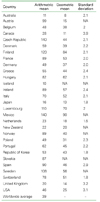2. United Nations Scientific Committee on the Effects of Atomic Radiation. Sources and effects of ionizing radiation: UNSCEAR 2000 report to the General Assembly, with scientific annexes. 2000. New York: United Nations.
3. National Institute of Environmental Research. National radon survey in Korea. 2009. Incheon: National Institute of Environmental Research.
4. Man-made mineral fibres and radon: summary of data reported and evaluation. IARC monographs. Vol. 43 [Internet]. International Agency for Research on Cancer. 1988. cited 2012 Feb 3. Lyon: International Agency for Research on Cancer;Available from:
http://monographs.iarc.fr/ENG/Monographs/vol43/volume43.pdf.
5. Darby SC, Hill DC. European Collaborative Group on Rasidential Radon and Lung Cancer. Health effects of residential radon: a European perspective at the end of 2002. Radiat Prot Dosimetry. 2003. 104:321–329.

6. Agency for Toxic Substances and Disease Registry. Toxicological profile for radon. 2008. Atlanta: Agency for Toxic Substances and Disease Registry.
8. Lubin JH, Wang ZY, Boice JD Jr, Xu ZY, Blot WJ, De Wang L, Kleinerman RA. Risk of lung cancer and residential radon in China: pooled results of two studies. Int J Cancer. 2004. 109:132–137.

9. Turner MC, Krewski D, Chen Y, Pope CA 3rd, Gapstur S, Thun MJ. Radon and lung cancer in the American Cancer Society cohort. Cancer Epidemiol Biomarkers Prev. 2011. 20:438–448.

10. Ministry of Health and Welfare. The Korea Central Cancer Registry. Annual report of cancer statistics in Korea in 2008. 2010. Seoul: Ministry of Health and Welfare.
11. Statistics Korea. Annual report on cause of death statistics. 2010. Daejeon: Statistics Korea.
12. Occupational Safety and Health Research Institute. Study of lung cancer incidence through miners with pneumoconiosis cohort. 2002. Incheon: Occupational Safety and Health Research Institute.
13. Yoon S, Chang BU, Kim Y, Byun JI, Yun JY. Indoor radon distribution of subway stations in a Korean major city. J Environ Radioact. 2010. 101:304–308.

14. Song MH, Chang BU, Kim Y, Cho KW. Radon exposure assessment for underground workers: a case of Seoul subway police officers in Korea. Radiat Prot Dosimetry. 2011. 147:401–405.

15. Natural Radioactivity Environmental Health Center [Internet]. 2011. cited 2011 Dec 17. Wonju: Environmental Health Center;Available from:
http://radonkorea.webmind.kr.
16. Darby SC, Whitley E, Howe GR, Hutchings SJ, Kusiak RA, Lubin JH, Morrison HI, Tirmarche M, Tomásek L, Radford EP. Radon and cancers other than lung cancer in underground miners: a collaborative analysis of 11 studies. J Natl Cancer Inst. 1995. 87:378–384.

17. Rericha V, Kulich M, Rericha R, Shore DL, Sandler DP. Incidence of leukemia, lymphoma, and multiple myeloma in Czech uranium miners: a case-cohort study. Environ Health Perspect. 2006. 114:818–822.

18. Smith BJ, Zhang L, Field RW. Iowa radon leukaemia study: a hierarchical population risk model for spatially correlated exposure measured with error. Stat Med. 2007. 26:4619–4642.

19. Bolviken B, Celius EG, Nilsen R, Strand T. Radon: a possible risk factor in multiple sclerosis. Neuroepidemiology. 2003. 22:87–94.

20. Laurier D, Valenty M, Tirmarche M. Radon exposure and the risk of leukemia: a review of epidemiological studies. Health Phys. 2001. 81:272–288.
21. Mohner M, Lindtner M, Otten H, Gille HG. Leukemia and exposure to ionizing radiation among German uranium miners. Am J Ind Med. 2006. 49:238–248.

22. Villeneuve PJ, Morrison HI. Coronary heart disease mortality among Newfoundland fluorspar miners. Scand J Work Environ Health. 1997. 23:221–226.

23. Villeneuve PJ, Lane RS, Morrison HI. Coronary heart disease mortality and radon exposure in the Newfoundland fluorspar miners' cohort, 1950-2001. Radiat Environ Biophys. 2007. 46:291–296.

24. Xuan XZ, Lubin JH, Li JY, Yang LF, Luo AS, Lan Y, Wang JZ, Blot WJ. A cohort study in southern China of tin miners exposed to radon and radon decay products. Health Phys. 1993. 64:120–131.

25. Tomasek L, Swerdlow AJ, Darby SC, Placek V, Kunz E. Mortality in uranium miners in west Bohemia: a long-term cohort study. Occup Environ Med. 1994. 51:308–315.

26. Kreuzer M, Kreisheimer M, Kandel M, Schnelzer M, Tschense A, Grosche B. Mortality from cardiovascular diseases in the German uranium miners cohort study, 1946-1998. Radiat Environ Biophys. 2006. 45:159–166.

27. Auvinen A, Salonen L, Pekkanen J, Pukkala E, Ilus T, Kurttio P. Radon and other natural radionuclides in drinking water and risk of stomach cancer: a case-cohort study in Finland. Int J Cancer. 2005. 114:109–113.









 PDF
PDF ePub
ePub Citation
Citation Print
Print


 XML Download
XML Download